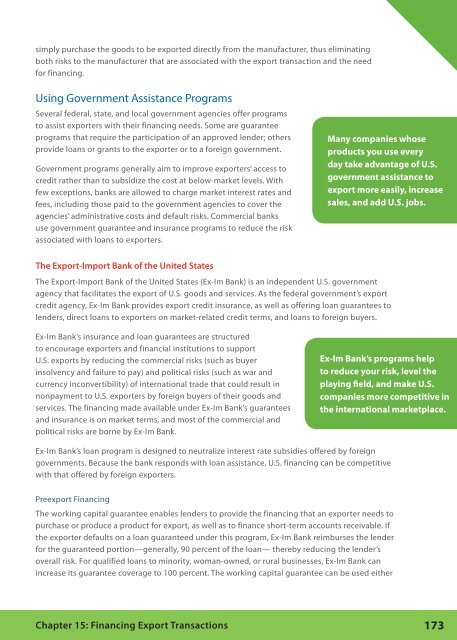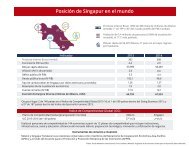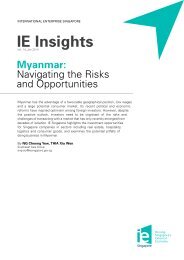basic-guide-to-exporting_Latest_eg_main_086196
basic-guide-to-exporting_Latest_eg_main_086196
basic-guide-to-exporting_Latest_eg_main_086196
Create successful ePaper yourself
Turn your PDF publications into a flip-book with our unique Google optimized e-Paper software.
simply purchase the goods <strong>to</strong> be exported directly from the manufacturer, thus eliminatingboth risks <strong>to</strong> the manufacturer that are associated with the export transaction and the needfor financing.Using Government Assistance ProgramsSeveral federal, state, and local government agencies offer programs<strong>to</strong> assist exporters with their financing needs. Some are guaranteeprograms that require the participation of an approved lender; othersprovide loans or grants <strong>to</strong> the exporter or <strong>to</strong> a foreign government.Government programs generally aim <strong>to</strong> improve exporters’ access <strong>to</strong>credit rather than <strong>to</strong> subsidize the cost at below-market levels. Withfew exceptions, banks are allowed <strong>to</strong> charge market interest rates andfees, including those paid <strong>to</strong> the government agencies <strong>to</strong> cover theagencies’ administrative costs and default risks. Commercial banksuse government guarantee and insurance programs <strong>to</strong> reduce the riskassociated with loans <strong>to</strong> exporters.Many companies whoseproducts you use everyday take advantage of U.S.government assistance <strong>to</strong>export more easily, increasesales, and add U.S. jobs.The Export-Import Bank of the United StatesThe Export-Import Bank of the United States (Ex-Im Bank) is an independent U.S. governmentagency that facilitates the export of U.S. goods and services. As the federal government’s exportcredit agency, Ex-Im Bank provides export credit insurance, as well as offering loan guarantees <strong>to</strong>lenders, direct loans <strong>to</strong> exporters on market-related credit terms, and loans <strong>to</strong> foreign buyers.Ex-Im Bank’s insurance and loan guarantees are structured<strong>to</strong> encourage exporters and financial institutions <strong>to</strong> supportU.S. exports by reducing the commercial risks (such as buyerinsolvency and failure <strong>to</strong> pay) and political risks (such as war andcurrency inconvertibility) of international trade that could result innonpayment <strong>to</strong> U.S. exporters by foreign buyers of their goods andservices. The financing made available under Ex-Im Bank’s guaranteesand insurance is on market terms, and most of the commercial andpolitical risks are borne by Ex-Im Bank.Ex-Im Bank’s programs help<strong>to</strong> reduce your risk, level theplaying field, and make U.S.companies more competitive inthe international marketplace.Ex-Im Bank’s loan program is designed <strong>to</strong> neutralize interest rate subsidies offered by foreigngovernments. Because the bank responds with loan assistance, U.S. financing can be competitivewith that offered by foreign exporters.Preexport FinancingThe working capital guarantee enables lenders <strong>to</strong> provide the financing that an exporter needs <strong>to</strong>purchase or produce a product for export, as well as <strong>to</strong> finance short-term accounts receivable. Ifthe exporter defaults on a loan guaranteed under this program, Ex-Im Bank reimburses the lenderfor the guaranteed portion—generally, 90 percent of the loan— thereby reducing the lender’soverall risk. For qualified loans <strong>to</strong> minority, woman-owned, or rural businesses, Ex-Im Bank canincrease its guarantee coverage <strong>to</strong> 100 percent. The working capital guarantee can be used eitherChapter 15: Financing Export Transactions173





